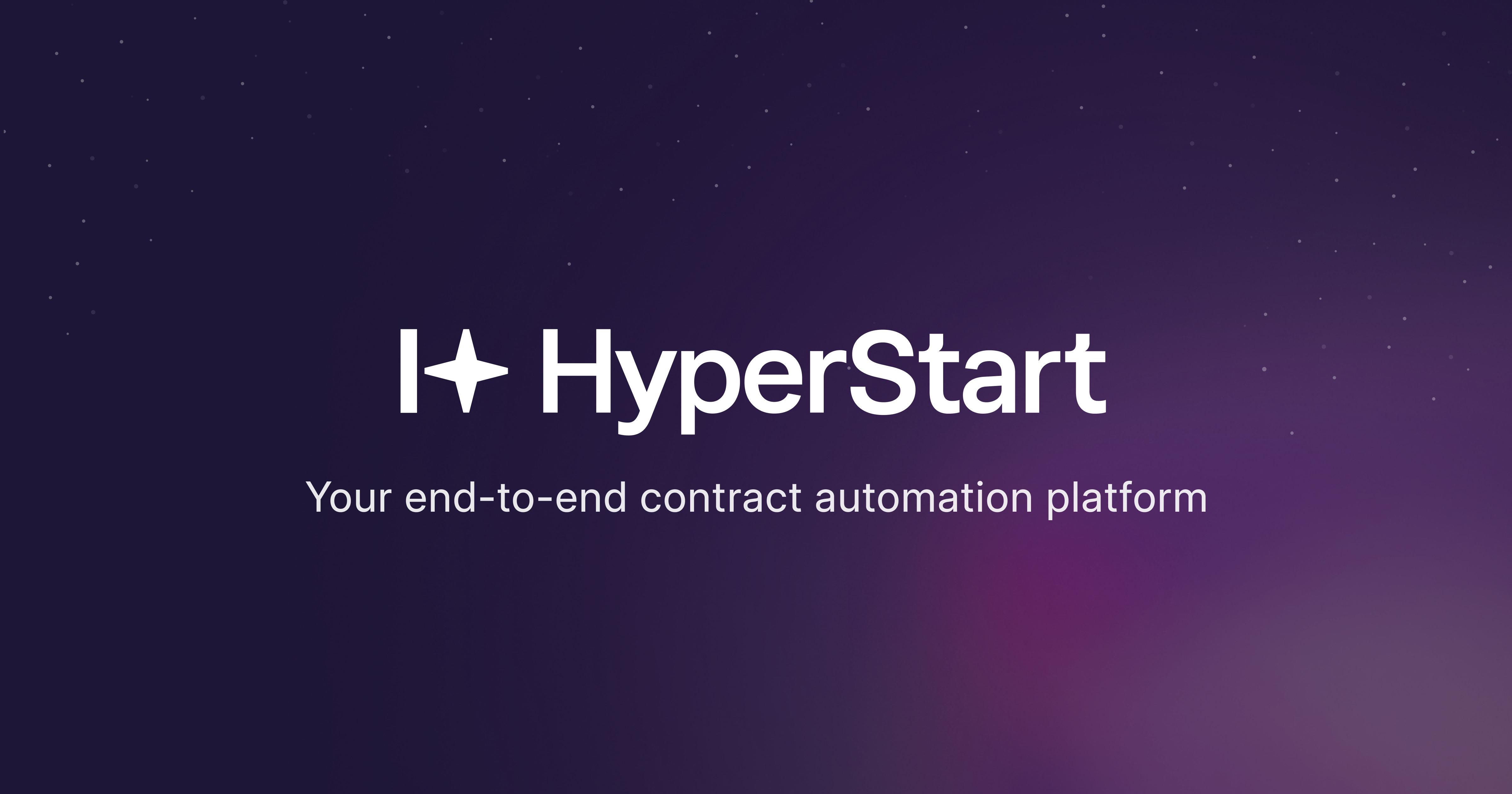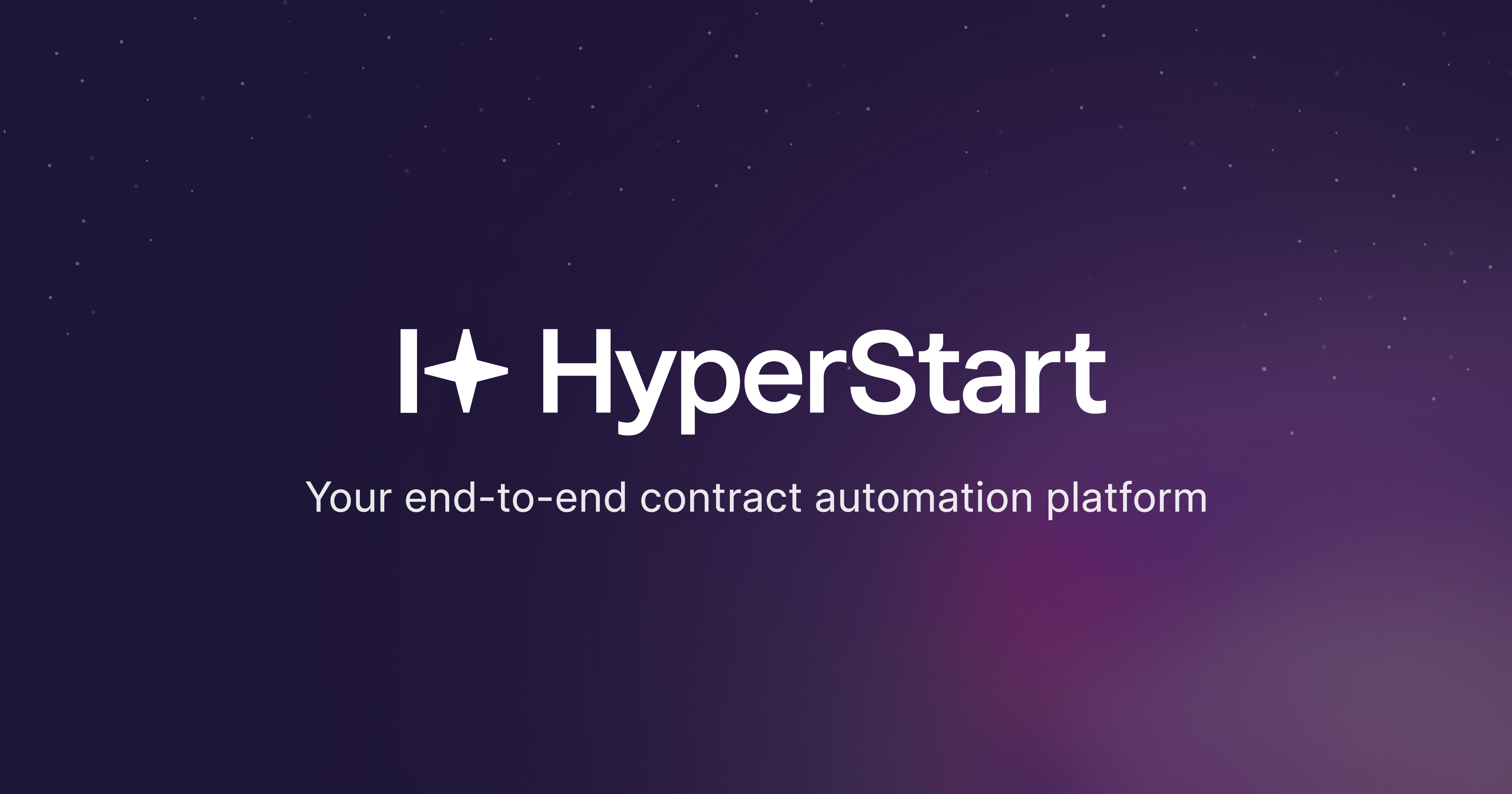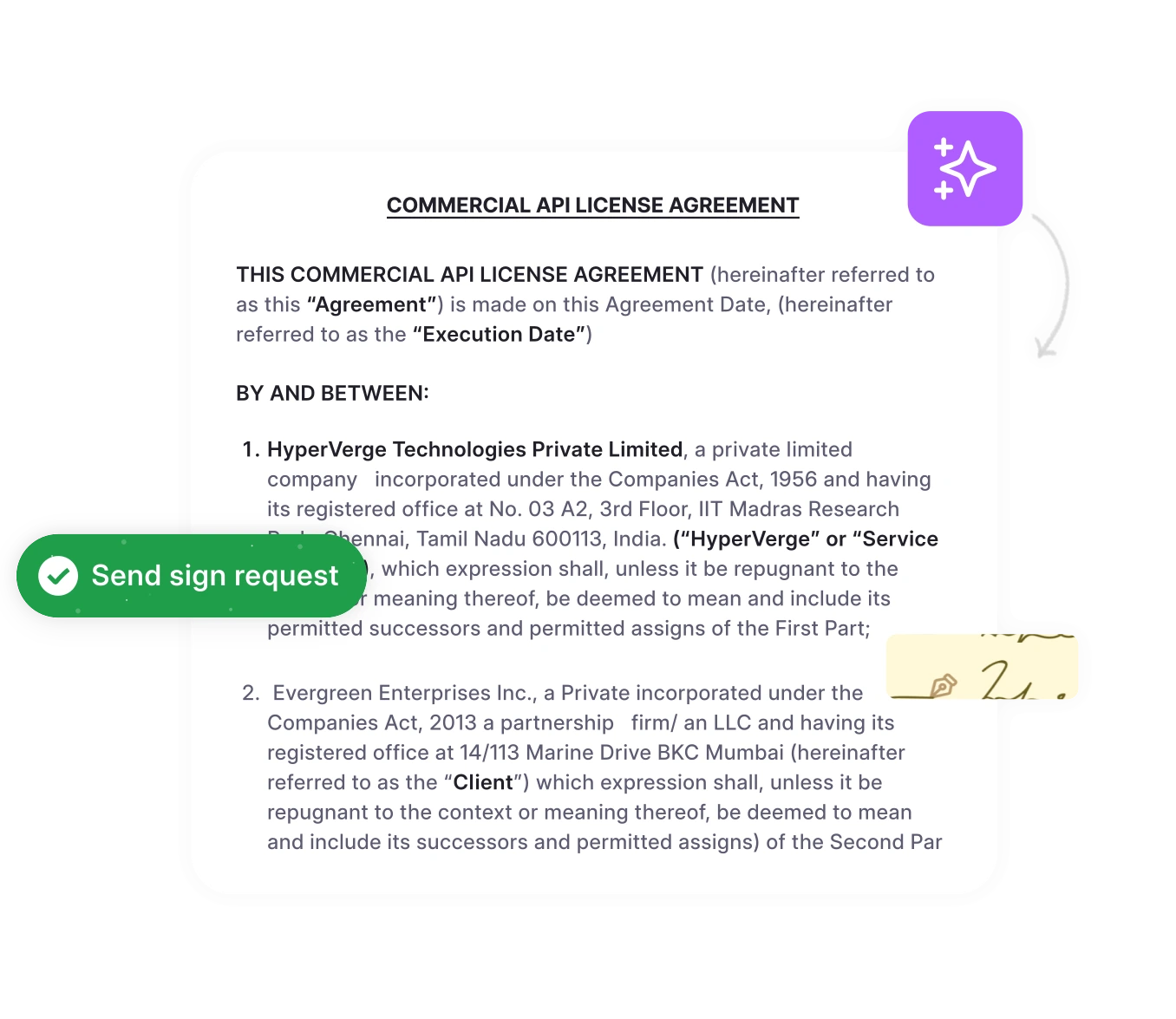Contract management is needed wherever there are contracts. Every department dealing with contracts—sales, legal, HR, procurement, or finance—needs to manage them as well.
Effective contract management improves legal compliance, helps fulfill contractual obligations, and ensures legal safeguards.
This blog walks you through the A-Z of managing contracts. Whether you are looking for the basics of agreement administration or want to improve your CLM processes through the latest best practices, we have covered it all for you. Let’s get started.
What is contract management?
Contract management is the process of creating, executing, and overseeing contracts between parties to ensure that terms are followed, obligations are met, and any issues or changes are addressed. It involves managing the entire contract lifecycle—from drafting and negotiation to performance tracking, renewal, or termination. Effective contract management ensures compliance, reduces risks, maximizes the value of the agreement for all parties, and ensures customer satisfaction.
In procurement operations, efficient contract management helps ensure that the suppliers meet the agreed terms and timelines for delivery. In sales operations, contract management tracks upcoming deal renewals and payments and minimizes the risk of non-compliance, thus improving customer experience.
Contracts are used by all departments, including sales, procurement, legal, finance, and HR. Thus, if your work involves dealing with contracts, knowing how to manage them is a must. Let’s discuss the ways of managing agreements.
What are the different ways to manage contracts?
Primarily, there are two ways to manage contracts: manual and automated.
Manual contract administration: Here, a dedicated contract manager manages contracts using traditional practices, typically through Spreadsheets and Excel.
Automated contract management: This approach uses contract management software to handle contracts. These software use AI to automate contractual tasks.
Automate Contract Management With AI
HyperStart CLM offers 99% accurate AI for end-to-end contract automation. Focus on what matters, and auto-pilot the rest.
Whether you automate contract management or follow manual approaches, it is essential to know that administering contracts is a multi-step process. Wondering what these steps are? Keep reading to find out.
What are the key steps in contract management?
The contract lifecycle process runs through 8 key stages: contract request generation, authoring, negotiation, approval, signing, obligation management, compliance monitoring, and renewal. Each of these stages aligns with the elements of a contract, ensuring legal validity and enforceability. Let’s understand each stage in detail.
| CLM Stage | Description |
| Contract request generation | The team requiring the contract generates the request for an agreement. This request includes details on the type of contract required, key stakeholders, and a brief agreement description. |
| Contract authoring | Based on the submitted requirements, the legal department starts drafting the contract. This includes creating the contract’s terms and clauses based on the agreement type. |
| Deal negotiation | Once drafted, the contract is reviewed, redlined, and negotiated. The negotiation process helps reach favorable contract terms and ensures the agreement is free from legal oversight. |
| Agreement approval | Every contract undergoes a unique approval workflow that passes through different departments, heads, and managers until all stakeholders have agreed to the contract. |
| Contract acceptance and signing | After approval, contracts are signed by all stakeholders. The signature flows vary from organization to organization. Once signed, the contract is executed. |
| Obligation management | Executed deals are tracked for obligations and deliverables. Tracking contract obligations helps fulfill the contract’s purpose and ensures adherence to the deal. |
| Compliance monitoring | Continuous compliance monitoring ensures legal and regulatory adherence. This stage helps realize and rectify discrepancies in legal compliance. |
| Contract renewal | After the contract’s term has ended, it is renewed for another term. If contracts are not renewed, they are considered terminated, thus ending the lifecycle. |
Now that we have answered your question “How to manage contracts?”, let’s understand how inefficient contract administration can harm your organization.
What are the challenges of contract management?
Not being able to manage your contracts efficiently can result in operational inefficiency and legal troubles. It may even hamper your organization’s growth. Let’s find out how.
1. Missed contract deadlines
Meeting contractual deadlines is an important part of fulfilling legal obligations. When contracts are not properly managed and monitored, organizations usually end up missing critical deadlines like renewal dates, deliverables, and payments. As per a survey by EY, only 22% of organizations track obligations systematically.
This is usually due to limited contract tracking that prevents organizations from keeping pace with deadlines and obligations. In many cases, missing deadlines also results in the contract’s termination and even hampers business relations with counterparties.
2. Legal repercussions from contract non-compliance
Not complying with the contract’s terms and clauses, such as an inability to fulfill the agreed terms (for service level agreements), or compromising on privacy and security (for NDAs), can result in legal repercussions.
Lawsuits and financial penalties usually stem from negligence in abiding by the contract’s requirements, a problem often caused by contract mismanagement.
3. Missed revenue opportunities due to poor contract visibility
Agreements present excellent opportunities for organizations to upsell, resell, and cross-sell their offerings. However, most organizations fail to realize these opportunities, mainly due to the lack of optimal contract visibility, which results in missed revenue opportunities.
Without clear insights into contract terms, counterparty requirements, and renewal dates, organizations often fail to utilize revenue opportunities to their full potential, causing revenue leakage.
4. Delays in contract execution
Organizations want to execute a deal as fast as possible, especially a sales deal. Contracts help bind the deal legally. However, delays in contract execution are common concerns.
Without a solid track record of contract performance, legal teams can better understand bottlenecks in the CLM processes. Contracts often get stuck in review cycles, negatively impacting project deadlines, efficiency, and organizational productivity.
5. Unidentified threats from poor contract risk management
Contracts provide insights into organizational threats and are vital for effective contract risk mitigation. Organizations, especially risk management departments, don’t have adequate visibility into business risks without an effective agreement management strategy. This can harm an organization in the long run.
These are the possible risks of poorly managing contracts, many of which stem from common contract management challenges. More often than not, organizations managing their agreements manually are likely to face these risks. So how do businesses manage contracts effectively and what are its benefits? Let’s learn.
Dodge Contract Risks With HyperStart CLM
Turn contracts into your brand’s growth powerhouse through AI that works.
What are the benefits of contract management?
Using a digital contract management solution helps automate the entire lifecycle—from contract creation to execution and analysis. Here’s how:
1. Better contract visibility
Contract management software offers real-time CLM insights—thus empowering legal and non-legal teams with in-depth CLM performance analysis. Legal professionals and contract managers can improve their decision-making with the latest contract metrics readily available.
2. Automated renewal tracking
Knowing about upcoming contract renewals helps prepare and negotiate new agreements on time. By the time the previous contract terms expire, organizations can have a new contract in place. With automation, it becomes easy to track upcoming agreement renewals. Automatic renewal reminders and visual dashboards help realize upcoming renewals on time.
3. Faster agreement creation
Drafting contracts manually is a time-consuming process that requires constant communication between different stakeholders. Moreover, manually creating contracts often results in legal loopholes, oversights, and missed deadlines.
Automated contract drafting, on the other hand, helps create contracts within minutes. With ready-to-use clause libraries, approved templates, and generative AI assistance, even non-legal teams can create new contracts within a few clicks and maximize operational efficiency.
5. Better brand experience
A sleek contracting experience helps build a positive brand image. This is especially true for SLAs, where you sign client contracts. Automation helps accelerate contractual processes from months to days, thus speeding up deal finalization. With fewer contract disputes, less friction, better compliance, and no bottlenecks, you can easily uplift your brand experience through contracts.
6. Less contract TAT
Contract turnaround time (TAT) is the total time required to manage contracts. The higher the contract TAT, the less time legal professionals have for other tasks. Contract lifecycle management tools help automate contractual tasks and accelerate TAT.
As a contract manager, automation can help you put all your repetitive CLM stages on auto-pilot mode, freeing up bandwidth for other important tasks.
This is how automated contract management systems can better manage contracts and improve your organization’s operational and financial performance. Apart from the above pros if you want to learn more then go through this detailed post on key benefits of contract management.
Now that we have covered all the bases for effective contract handling, let’s understand the latest contract administration best practices to help you fail-proof your agreement management approaches.
Automate Contracts With HyperStart CLM
HyperStart CLM offers complete functionalities for effortless contract management.
4 Contract management best practices to implement
1. Establish contract KPIs for improved performance insights
Contract management key performance indicators help measure the efficiency of your contract management processes. By establishing clear, measurable, and value-focused key contract metrics, you can get valuable insights into your contracts’ performance and take action to improve it.
2. Integrate with business apps for aligned workflows
Contracts are integral for sales, HR, procurement, legal, finance, and other departments. Since each department uses its unique apps and software, having standard connectivity with contracts is essential. Connecting your contract management platform with CRM, HRM, ERP, and other business apps allows you to streamline the contract lifecycle for all departments.
3. Standardize contract clauses
Inconsistency in contractual language is one of the major setbacks in contract management. It extends review time, creates legal loopholes, and even causes compliance issues. By standardizing contractual clauses, you can ensure that all the agreements are consistent, compliant, and sign-ready.
Moreover, creating a contract playbook can also be useful here in terms of contract standardizations. These playbooks govern how contracts are drafted, thus making agreements consistent throughout your organization and different departments.
4. Store contracts centrally
The key to efficient contract management is optimal contract visibility and instant accessibility. However, achieving this objective is challenging with contracts stored across different locations, such as drives, email inboxes, and CRMs. Moreover, similar contracts may have different versions stored in two different locations.
Central contract storage, on the other hand, helps solve this challenge. A central contract repository helps create a Single Source of Truth that contains all an organization’s agreements. Digital repositories like the one by HyperStart also help run audit trails and trace changes, thus adding security and accountability to agreements.
Set your contracts on auto-pilot with HyperStart
Effective contract management is essential for overall organizational success. This requires thoroughly understanding agreements, enabling analytics, and minimizing contract TAT. You can do all this with HyperStart—the one-stop platform for automated contract management.
With 99% accurate AI, budget-friendly pricing, and a complete suite of features for end-to-end contract lifecycle management, HyperStart CLM is an excellent choice for automating the contract lifecycle. Here’s what sets HyperStart CLM apart from other platforms:
80% faster contract turnaround time
70% time saved on contract admin
75% less negotiation time
10x faster contract review
$20 saved per contract
Is HyperStart CLM the right choice for your organization? Book a demo with our team today and start your FREE 7-day trial to see HyperStart CLM’s capabilities in action.
Frequently asked questions
However, a contract automation tool like HyperStart CLM can overcome this challenge and streamline contract administration.
As an end-to-end contract lifecycle management platform, HyperStart CLM offers all these features to help you fully automate and streamline contract management activities.
Therefore, while agreements can be managed without CLM software, using a dedicated contract management system is always a better choice in the long run.
These are a few general factors to consider while evaluating and selecting a contract administration platform.












